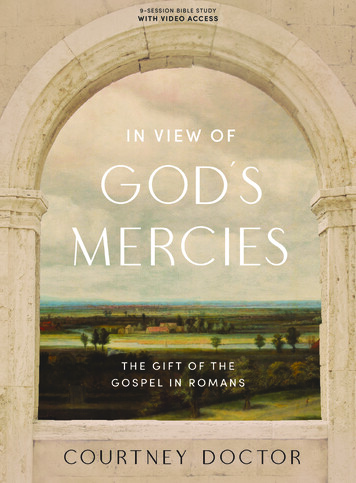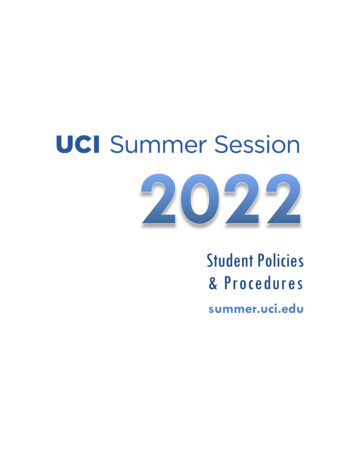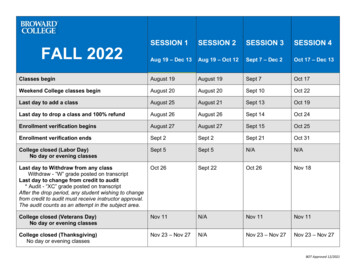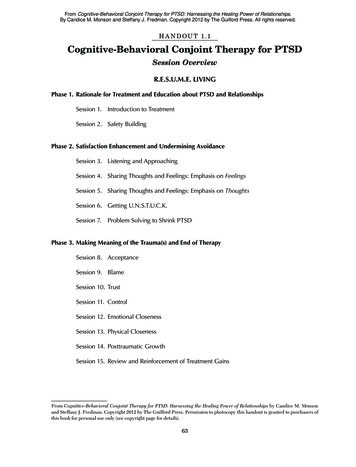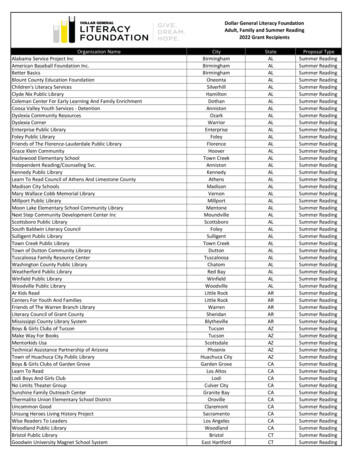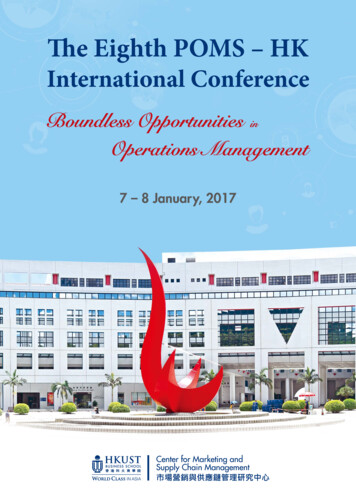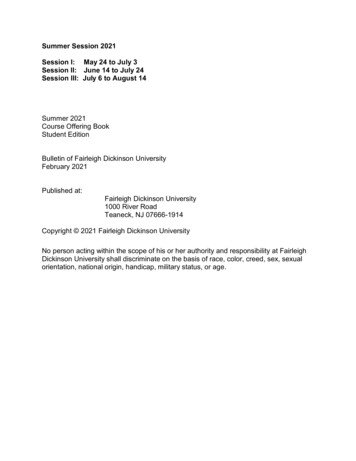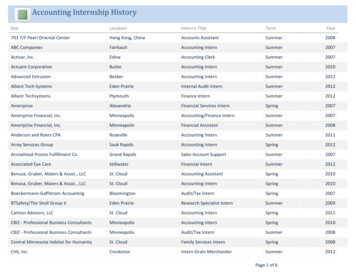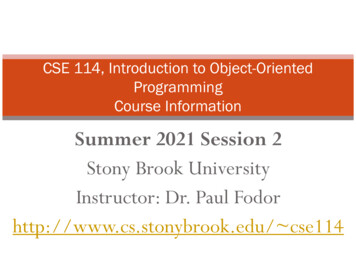
Transcription
CSE 114, Introduction to Object-OrientedProgrammingCourse InformationSummer 2021 Session 2Stony Brook UniversityInstructor: Dr. Paul Fodorhttp://www.cs.stonybrook.edu/ cse114
Course Description “Anintroduction to procedural and object-orientedprogramming methodology.Topics include program structure,conditional and iterative programming, procedures, arrays andrecords, object classes, encapsulation, information hiding,inheritance, polymorphism, file I/O, and exceptions. Includesrequired ts/UndergraduateStudies/courses/CSE114) Prerequisites: Level 4 or higher on the math placement exam(or MAT 123 ) Advisory Prerequisite: CSE 101 or ISE108.(c) Paul Fodor (CS Stony Brook)
Course Outcomes The following are the official course goals agreedupon by the faculty for this course: An ability to program in an object-oriented language,using concepts such as object classes, encapsulation,inheritance, and polymorphism. An ability to use fundamental data structures such asarrays. An ability to program with sound code structure anduse systematic software debugging and testingtechniques.(c) Paul Fodor (CS Stony Brook)
Major Course topics1. Procedural Programming Basics: data types variable declarations assignment statements & expressions input/output textual manipulation & strings conditional (branching) statements iteration loops and recursion method construction(c) Paul Fodor (CS Stony Brook)
Major Course topics2. Arrays: collect data in arrays searching sorting array manipulations(c) Paul Fodor (CS Stony Brook)
Major Course topics3. 4.Object Oriented Programming:designing and constructing classesaggregationinheritancepolymorphismabstract classes and interfacesRecursion(c) Paul Fodor (CS Stony Brook)
Instructor Information Dr. Paul Fodor214 New Computer Science Building Office hours: Mondays and Wednesdays 5-6:30PM onGoogle Meet Phone: 1 (631) 632-9820 Email: paul (dot) fodor (at) stonybrook (dot) edu Please include “CSE 114” in the email subject and your namein your email correspondence Course Web page: http://www.cs.stonybrook.edu/ cse114 Blackboard will be used for assignments, grades andcourse material.(c) Paul Fodor (CS Stony Brook)
General Information Meeting Information (Class Time and Place): Lecture: MoWe 1:30PM - 3:30PM, online on Zoom(see Blackboard for link). Laboratory: MoWe 3:45PM - 5:00PM, online on Zoom(same link used by the lecture).(c) Paul Fodor (CS Stony Brook)
Textbook Optional: Introduction To Java Programming,Comprehensive Version, Author: Daniel Liang,Publisher: Pearson , Edition: 11th, 2017.(c) Paul Fodor (CS Stony Brook)
Software Necessary Software: Java Developer Kit (JDK): download fromhttps://java.com/en/download/ You should download JDK for your operating system(cost: free) Eclipse IDE: https://www.eclipse.org You should download the Eclipse IDE for JavaDevelopers (cost: free)(c) Paul Fodor (CS Stony Brook)
Coursework Grading Schema Grades will be based on homework and examsaccording to the following formula: Homework assignments -- 15% Labs -- 10% Midterm exams (2) -- 50% (25% each) Final exam -- 25%(c) Paul Fodor (CS Stony Brook)
Coursework Grade Cutoffs A [95-100], A- [90-95), B [87-90), B [83-87),B- [80-83), C [77-80), C [73-77), C- [7073), D [65-70), D [60-65), F [0-60) SPECIAL RULE: If all your grades, includinghomework assignments, quizzes, recitationand your three exam grades are above therespective class averages, you're guaranteed toreceive a grade of C or higher for this class.(c) Paul Fodor (CS Stony Brook)
Important Dates Midterm Exam #1: Wednesday, July 14, 2021,during class time 1:30PM - 3:30PM (120 minutes),online with LockDown Browser with Monitoring. Midterm Exam #2: Wednesday, July 28, 2021,during class time 1:30PM - 3:30PM (120 minutes),online with LockDown Browser with Monitoring. Final Exam: FINAL EXAM: Wednesday, August 11,2021, during class time 1:30PM - 3:30PM (120minutes), online with LockDown Browser withMonitoring.(c) Paul Fodor (CS Stony Brook)
Assignments Homework assignments due on fixeddates and times no late submission is permitted All assignments should be submittedelectronically Blackboard14(c) Paul Fodor (CS Stony Brook)
Lab exercises Simple Coding Exercises TAs will present problems that you must implement and submitby the end of the day of the lab Submit your lab work on Blackboard for lab credit by the endof the lab day0 –3 points: 0 - Student did not submit the lab or program does not even compile 1 - Student submitted the lab, program compiles but has majorproblems 2 - Student submitted the lab, and program partially works (with someerrors) 3 - Student submitted the lab and the program is correct15(c) Paul Fodor (CS Stony Brook)
Regrading of Homework/Exams Please meet with a grading TA or theinstructor and arrange for regrading You have one week from the daygrades are posted or mailed orannounced! Late requests will not be entertained16(c) Paul Fodor (CS Stony Brook)
Class Schedule17Week Lecture Topics1Introduction to Computers, Programming and Java,Elementary Programming2Selections, Mathematical Functions, Characters, andStrings, Loops3Methods, Arrays4Multi-dimensional Arrays5Objects and Classes, Object-Oriented Thinking6Inheritance and Polymorphism7Exception Handling and Text I/O, Abstract Classes andInterfaces8Recursion(c) Paul Fodor (CS Stony Brook)
Student Accessibility Support Center If you have a physical, psychological, medical or learning18disability that may impact your course work, please contactStudent Accessibility Support Center, ECC (EducationalCommunications Center) Building, Room 128, (631)6326748. They will determine with you what accommodations, ifany, are necessary and appropriate. All information anddocumentation is confidential Students who require assistance during emergency evacuationare encouraged to discuss their needs with their professors andStudent Accessibility Support Center. For procedures andinformation go to the following ities All documentation of disability is confidential(c) Paul Fodor (CS Stony Brook)
Academic Integrity The following rules are posted in every coursesyllabus: "Each student must pursue his or her academicgoals honestly and be personally accountable for allsubmitted work. Representing another person's work as yourown is always wrong. Any suspected instance ofacademic dishonesty will be reported to theAcademic Judiciary. For more comprehensive informationon academic integrity, including categories of academicdishonesty, please refer to the academic judiciary website athttp://www.stonybrook.edu/commcms/academic integrity/"19(c) Paul Fodor (CS Stony Brook)
Academic Integrity You can discuss general assignment concepts with other students:explaining how to use systems or tools and helping others withhigh-level design issues You MAY NOT share assignments, source code or otheranswers by copying, retyping, looking at, or supplying a file Assignments are subject to manual and automated similaritychecking (We do check! and our tools for doing this are muchbetter than cheaters think) If you cheat, you will be brought up on academicdishonesty charges - we follow the university policy: c) Paul Fodor (CS Stony Brook)
Examples of Academic Dishonesty Unpermitted collaboration (on a paper, homework, lab reports, etc.).Unless an instructor has explicitly approved working together,students should assume, for their own protection, that it is notpermitted. Helping someone else to plagiarize from one's own homework (forexample, by giving them a copy of yours, or doing it for them) This includes having a public repository on Github that other students cancopy from. Representing someone else's source code as one's own. If anotherperson's code is being used, it must be properly cited. Buying or selling source code. Using source code or pieces of a paper from the internet withoutproperly citing the source.21(c) Paul Fodor (CS Stony Brook)
Academic Dishonesty The instructor makes a recommendation at theAcademic Judiciary office Cheating is cheating! No matter the amount ofcheating or if one is the source or destination ofcheating. Do not cheat! You are cheating yourself. Our job is the teach you the material and make surethat you learn it. Our recommendation is always F for the cheaters!22(c) Paul Fodor (CS Stony Brook)
Catastrophic events Major illness, death in family Formulate a plan (with your CEAS academicadvisor) to get back on track Advice Once you start running late, it’s really hard tocatch up23(c) Paul Fodor (CS Stony Brook)
Piazza The Piazza discussion board should be used for allcommunication with the teaching staff for questionsabout the course assignments and material Piazza is a forum for additional learning and assistance You are expected to use the Piazza forum for all nonpersonal, course-related communication Like questions about what a homework problem is asking,technical problems that need troubleshooting, or otherquestions that might be of interest to other students must beposted to Piazza and not emailed to the instructor or a TA24(c) Paul Fodor (CS Stony Brook)
Piazza The following are NOT appropriate uses of Piazza: cyber-bullying posting memes complaining about a grade airing concerns/comments/criticisms about the course posting more than a few lines of source code from an attemptat a homework problem posting the solution to a homework problem or a link to awebsite containing the solution in general, anything unrelated to the course material andstudent learning Anonymous posting is turned off, so we can see who you are.25(c) Paul Fodor (CS Stony Brook)
Email Etiquette When emailing your instructor about the course, use thefollowing guidelines to ensure a timely response: use your official @stonybrook.edu email account (wecannot respond to other emails due to FERPA regulations) use a descriptive subject line that includes "CSE114" and abrief note on the topic begin with a proper greeting, such as "Hi Prof. Fodor" briefly explain your question or concern or request includingthe course (we are teaching several courses) end with a proper closing that includes your full name, Net IDand SBU ID number26(c) Paul Fodor (CS Stony Brook)
What do you need to get started? Blackboard account http://blackboard.stonybrook.edu Java Developer Kit 8 (JDK): download fromhttps://java.com/en/download/ You should download JDK for your operating system (cost: free) Eclipse IDE: https://www.eclipse.org You should download the Eclipse IDE for Java Developers (cost: free) Learn to use the debugger!!! Optional: Liang’s student Web site: https://yongdanielliang.github.io27(c) Paul Fodor (CS Stony Brook)
Tools for Writing Java Programs 1st Approach – the bare minimum edit Java source code in text editor (ex: Notepad or Pico) compile source code into class files from command line: javac can be tedious poor interactivity 2nd Approach – Integrated Development Environment (IDE) combines writing, compiling, running and debugging Javacode into a single application makes coding much more efficient and organized Eclipse, NetBeans, etc.28(c) Paul Fodor (CS Stony Brook)
Java: How does it work? Java Source Code you write ?.java files Compile your Programjavac ?.javaOR Build menu option in the Run menu included in theEclipse IDE The Result is: Java Executable Code (bytecode) ?.class files Java bytecode - not humanly readable Now you can run your java program using the Java VirtualMachine (JVM):java YourProgramName29OR Run button included in the Eclipse IDE(c) Paul Fodor (CS Stony Brook)
Please Please be on time Please show respect for your classmates Please turn off (or use vibrate for) yourcellphones. On-topic questions are welcome30(c) Paul Fodor (CS Stony Brook)
Welcomeand Enjoy!(c) Paul Fodor (CS Stony Brook)
(c) Paul Fodor (CS Stony Brook) Lab exercises Simple Coding Exercises TAs will present problems that you must implement and submit by the end of the day of the lab Submit your lab work on Blackboard for lab credit by the end of the lab day 0 -3 points: 0 - Student did not submit the lab or program does not even compile 1 - Student submitted the lab, program compiles but has major
